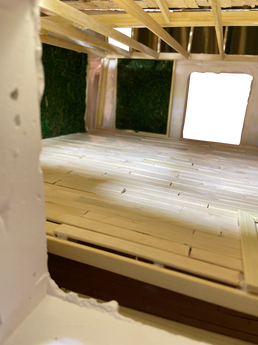Seaweed Research Quarters
Date
Year 3 Architecture 2023/24
Location
Roosevelt, Connemara, Galway, Ireland
Project Type
Sustainable Design, Educational
This project is situated on the west coast of the country, within
Galway county’s Connemara region, adjacent to the Pacific
Ocean and neighboring two Shellfish Companies and Mungo’s
Small Business, which specialize in seaweed, abalone, sea
cucumber, and sea urchin products. The initiative is focused on
harnessing the site’s potential for communal benefit through the
establishment of a research facility dedicated to exploring the
multifaceted uses of seaweed in construction materials, culinary
applications, and skincare remedies.


Granite, Clay, Hay, Seashells, Seaweed which can be used with traditional techniques into creating a new building.
Seaweed is right infront of the site and it grows in abundace throughout the year. I investigated different ways that these could be harvested and maybe even use as a construction material.
A licence under the 1933 Foreshore Act is not required by the holder of that right in order to harvest seaweed, nor can any other entity be licenced under the Foreshore Act to harvest seaweed in an area where existing formal or informal rights to harvest seaweed already exist.
Regime under the Foreshore Act 1933 (as amended), managing a range of different marine activities and infrastructural developments. Section 3 of the Act provides for the granting of a licence for the removal of or the disturbance of beach material on the Foreshore.


Active aquaculturalists: These are individuals with licensed sites for seaweed culture, individuals involved in aquaculture (abalone farmers) who wish to start seaweed culture to feed farmed abalone and urchins; and (2) processors:- individuals who are involved in processing wild seaweed for the food sector.



Low Tide
High Tide



Ground Floor



Existent
New
Green Space
First Floor




Drying Seaweed
Sun drying (SD): wet biomass was incubated directly under the sun for 48 hours in a location that allows the maximum of illumination hours
Air drying (AD): biomass was covered with 4 layers of aluminum and incubated at room temperature for 48 hours

Harvesting Seaweed
Foraging involves harvesting food from the wild, typically by a small number of people, causing minimal impact as only necessary amounts are taken.
Developed in the 1960s, the Scoubidou is a curved iron hook on a hydraulic arm that uproots and pulls kelp aboard a dredger, harvesting about 2 tonnes per day per boat.
Mechanical harvesting has increased due to a decline in young people willing to do the work and economic benefits. These methods are used globally and could be adopted in Ireland.
Inspired by the Norway Dredge, this 3m iron sledge with forward-pointing forks is dragged by a trawler, cutting kelp larger than 20cm and leaving smaller plants for regrowth. It can harvest up to 150 tons daily, though videos show it may uproot entire plants.
Kelp is suctioned into a cutter, then transported to the boat. The cutter’s depth is controlled by sonar and sometimes underwater cameras.


Drawing inspiration from Irish vernacular architecture, I seek to experiment with materials readily available on site, including seaweed, seashells, and earth. This approach not only promotes eco-friendliness and carbon negativity but also reflects a deep-rooted tradition of incorporating locally sourced elements into architectural designs, thus enriching the connection between contemporary practices and indigenous building techniques.
Armourcoat have helped our unit with adapting their sustainable lime-based finishes with our seaweed and seashells. From subtle textures to striking patterns, these finishes redefine elegance and sophistication in interior and exterior designs.






Kelp (Laminaria digitata)
Minerals: Calcium, Magnesium, Manganese, Copper, Zinc, Riboflavin, Niacin, Thiamine
Vitamins A, B12, B6, C, and D
Carrageen Moss (Chondrus Chrispus)
Traditional remedy for respiratory ailments
Channel Wrack
(Pelvetia Canaliculata)
Rich in omega 3, fatty acids EPA and DHA
Sargassum
(Sargassum Muticum)
Rich in antioxidant compounds, pigments (fucoxanthin) and vitamins C, K, E
Scurvy Grass (Cochlearia Officinalis)

Alaria (Alaria Esculent)
Calcium
Vitamin A and B
Fiber

Velvet Horn
(Codium Tomentosum)

Dillisk/Dulse (Palmaria Palmata)
Rich in vitamins, minerals

Dulse (Osmundea Pinnatifida, Chondrus Chrispus)
Strong Peppery, Truffle and sea smell and taste

Sea Lettuce (Ulva lactuca)
High in Iron
Minerals: Iodine, Calcium, Aluminum, Manganese, Magnesium, Sodium, Potassium, Copper, Zinc
27% protein content

Sea Spaghetti (Himanthalia elongata)
Minerals: Magnesium, Calcium, Potassium, Iodine and Sodium

Sea Grass (Ulva intestinalis)
Minerals: Calcium, Potassium, Magnesium, and Phosphorus and Cobalt, Copper, Iron, Manganese, Nickel and Zinc.
Vitamins: Polyunsaturated Fatty Acids, Omega 3 and 6 oils
July
June
May
April
March
February
January
August
September
October
November
December









